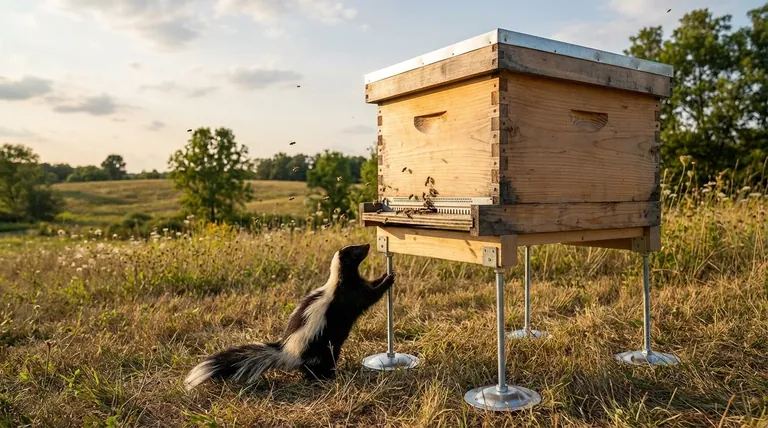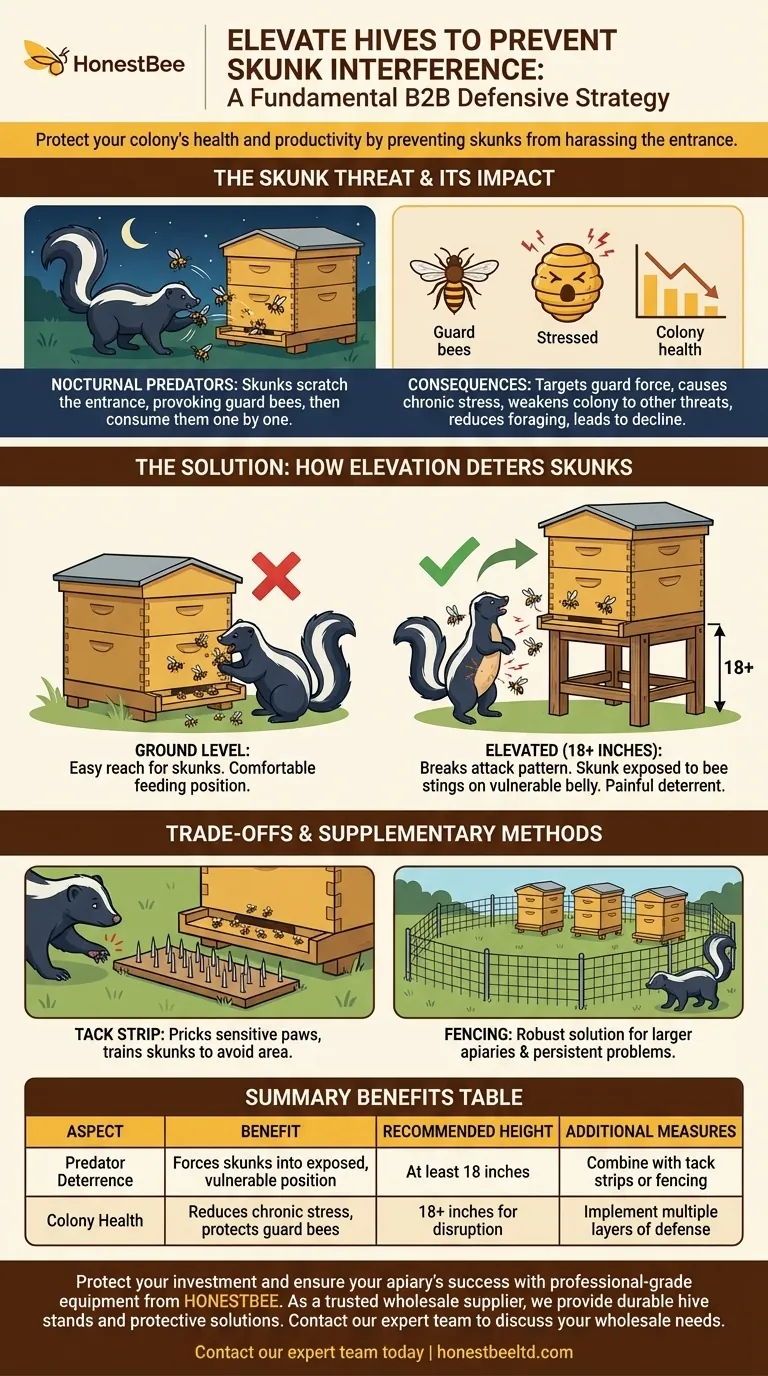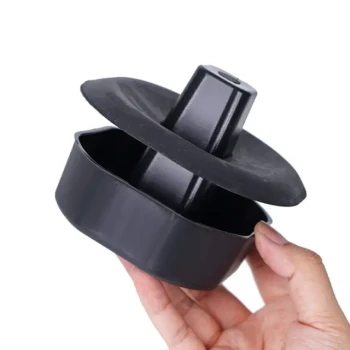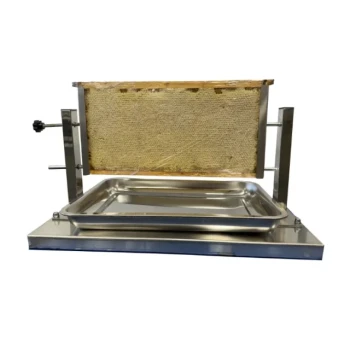Elevating your beehives is a fundamental defensive strategy against skunks. This simple physical adjustment prevents these nocturnal predators from easily reaching the hive entrance, where they harass and consume your bees, weakening the entire colony over time.
The core issue is not just the loss of a few bees; it's the chronic stress and depletion of the colony's guard force. Elevating a hive disrupts a skunk's natural attack method, making it an effective, low-effort solution to a significant threat.

The Threat Skunks Pose to a Hive
A skunk is more than a minor nuisance; it is a persistent predator that can systematically degrade a colony's health and productivity. Understanding their method of attack reveals why they are so damaging.
How Skunks Attack
Skunks are creatures of habit. They typically visit the apiary at night, approach a hive, and scratch at the front entrance or on the landing board.
This disturbance provokes the colony's guard bees, which fly out to investigate and defend the hive. As the bees emerge, the skunk catches and eats them one by one.
The Impact on Colony Population
A skunk doesn't eat a random assortment of bees; it specifically targets and consumes the guard bees.
Losing these defenders is a critical blow. A reduced guard force makes the hive more vulnerable to other threats, such as robbing by wasps or other bees, which can quickly decimate a weakened colony.
The Stress Factor
Constant nightly harassment puts the colony under immense stress. This can lead to a more aggressive and defensive hive during the day, making inspections difficult for the beekeeper.
Over time, this chronic stress depletes the colony's energy, reduces foraging activity, and can contribute to its overall decline or failure to thrive.
How Elevation Deters Skunks
Elevating the hive is effective because it directly interferes with the skunk's physical ability to hunt at the entrance.
Breaking the Attack Pattern
To scratch at a hive entrance, a skunk must stand on its hind legs and place its front paws on the hive body. This is a comfortable and stable position for them.
By raising the hive entrance to a height of at least 18 inches, you force the skunk to stand fully exposed to attack the entrance. This exposes their vulnerable, less-furred underbelly to bee stings. Skunks are intelligent and quickly learn to avoid this painful experience.
The Ideal Hive Stand
A proper hive stand is the most common and effective way to achieve the necessary height. Stands made of wood or metal place the entire hive well out of a skunk's comfortable reach.
This simple piece of equipment is one of the most important investments for protecting your bees from ground-level predators.
Understanding the Trade-offs and Other Methods
While highly effective, elevation is one tool in a beekeeper's pest management toolkit. For persistent problems, it works best in combination with other methods.
The Limits of Elevation Alone
A very determined skunk might still attempt to climb a hive stand. While elevation deters the vast majority of skunks, it may not be a complete solution in areas with high predator pressure.
Alternative: The "Tack Strip" Guard
A common and highly effective supplement is to create a "tack strip" or carpet tack board. This is a piece of wood with many nails or tacks driven through it, points-up.
Placing this board on the ground directly in front of the hive entrance will prick the skunk's sensitive paws as it approaches, teaching it to stay away from the hive entirely.
Fencing and Apiary Placement
For larger apiaries or areas with significant predator challenges, installing a low-strand electric fence or poultry netting around the perimeter can offer a more robust, large-scale solution against skunks and other animals.
Making the Right Choice for Your Goal
Protecting your colonies requires a proactive approach based on your specific situation.
- If you are setting up a new apiary: Install hive stands that elevate your colonies at least 18 inches from the ground from day one.
- If you suspect skunk activity (scratches on the hive, piles of chewed bees): Immediately elevate the affected hives and consider adding a tack strip guard in front of the entrance for added deterrence.
- If you have a persistent predator problem: Combine elevated hive stands with a perimeter fence to create multiple layers of defense for your entire bee yard.
By implementing these simple defensive measures, you protect your bees from nightly stress and ensure your colonies remain strong, healthy, and productive.
Summary Table:
| Aspect | Benefit of Elevating Hives |
|---|---|
| Predator Deterrence | Forces skunks into an exposed position, making them vulnerable to bee stings. |
| Colony Health | Reduces chronic stress and protects the vital guard bee population. |
| Recommended Height | At least 18 inches from the ground to effectively disrupt skunk attacks. |
| Additional Measures | Can be combined with tack strips or fencing for maximum protection. |
Protect your investment and ensure your apiary's success with professional-grade equipment from HONESTBEE.
As a trusted wholesale supplier for commercial apiaries and beekeeping equipment distributors, we provide the durable hive stands and protective solutions you need to effectively deter predators like skunks. A strong defense leads to healthier, more productive colonies and higher honey yields.
Contact our expert team today to discuss your wholesale needs and discover how our equipment can fortify your beekeeping operation.
Visual Guide

Related Products
- Metal Hive Feet Bee Hive Stand for Ant Protection
- Metal Bee Hive Stand Bee Box Stand for Beekeeping
- Plastic Bee Hive Stand for Beekeeping
- Professional Ant-Proof Beehive Stand with Integrated Moat for Beekeeping
- Ergonomic Two Person Foldable Hive Lifter
People Also Ask
- How do bees regulate the temperature of their hive during the summer? Discover Their Natural Cooling System
- What is the best height for a hive stand? Optimize for Pest Control and Beekeeper Ergonomics
- Why should beekeepers consider using hive stands? Protect Your Hives and Your Back
- How do bees regulate ventilation and temperature in the hive? Master Hive Climate Control
- How can hive stands be made more secure in windy areas? Anchor Your Apiary Against the Elements



















